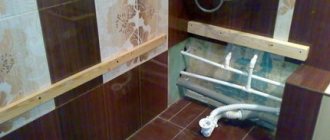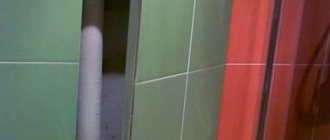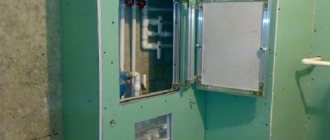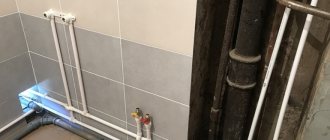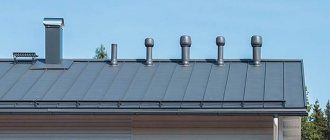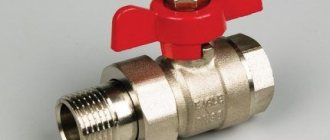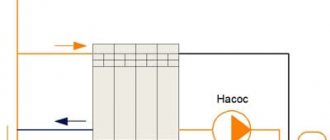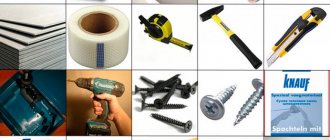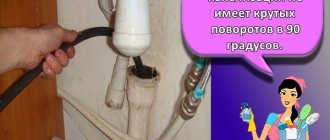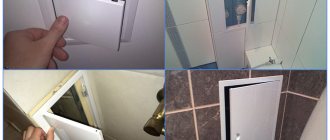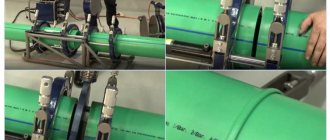Installing water supply and sewer lines with your own hands requires a responsible approach to the event, otherwise everything may end in malfunction of the system or an accident. The first step is to study what bathroom pipes are used, what methods are used to connect them, and how to lay them correctly. In this article we will study the types of pipes and analyze the options for connecting them, with attached photo and video lessons.
Bathroom pipes
Before we study what pipes are needed for the bathroom, we will first look at the options for installing them in the room. This will help us in planning when arranging plumbing fixtures and will make it possible to clearly calculate the amount of material.
Do-it-yourself plumbing installation in the bathroom: features
Before laying communications in the bathrooms of a private house, it is necessary to accurately and finally decide on the choice of models of all plumbing fixtures: bathtub, shower cabin, toilet, washbasin, heated towel rail, etc.
Technik-san
Find a factory technical map with installation dimensions on the Internet, or take it from the seller, and only then start laying routes for water supply and sewerage.
Here is a striking example: this picture shows that the same toilet model can have four types of water connections (bottom, left, right or middle) - it all depends on what kind of drainage mechanism the tank is equipped with.
Here are some standard connection diagrams for installing toilets:
And photos of their implementation from Technik-san:
To successfully install corner bathtubs with a load-bearing frame, you need to take a frame diagram from the seller - it is not always possible to “untie” the bathroom drain according to the usual diagram. And only if you are 100% sure that you will definitely buy completely ordinary, run-of-the-mill plumbing fixtures, you can follow the standard sizes from our table.
| Plumbing fixture | Level of entry of a 50mm sewer pipe from the wall (from the level of the finished floor) |
| Bath or shower with tray | 60 mm (from the level of the floor tiles to the axis of this pipe). If the output of the channel is higher than this value, you will have to make a podium. |
| Wash basin | 530-550 mm. |
| Attached toilet | 180-190 mm. |
| Wall-hung toilet | 220-240 mm. |
| Washing machine | 600 – 700 mm. |
Material selection
Water pipes
The current market offers the following types of water pipes:
- Steel without anti-corrosion coating;
- Galvanized steel;
- Stainless steel corrugated;
- Copper;
- Polypropylene (without reinforcement, with reinforcement with aluminum foil and chopped fiberglass);
- Metal-plastic;
- Polyethylene.
Regular polyethylene can only be used in cold water due to its limited heat resistance. For DHW distribution, its modifications are used - cross-linked polyethylene PE-X and thermally modified PE-RT.
The photo shows a heat-resistant PE-RT pipe.
How to distribute the water supply in a private house with its own boiler or water heater is a matter of personal preference. I use polypropylene on one floor, metal-plastic on the other, and both materials do not cause the slightest complaints.
Metal-plastic water supply in the attic floor of my house.
But in a city apartment with centralized hot water supply, I strongly advise using only metal pipes , preferably corrosion-resistant ones.
What is this instruction related to?
There is a high probability of force majeure during the operation of the hot water supply system.
First, a little theory.
According to current SNiP, the temperature of any utility line in a residential building should not exceed 95 degrees Celsius. The working pressure in the DHW system is 3-7 kgf/cm2. In summer, the hot water supply is fed from the supply line of the heating main; in winter, when it reaches 80-90 degrees, it must switch to the return line.
During the peak of cold weather, the supply coolant temperature can reach 150 degrees. Water does not boil only due to increased pressure.
Graph of heating main temperature depending on weather conditions.
However, in some cases the standard values of temperature and pressure can be significantly exceeded.
- If the mechanic forgets or is too lazy to switch the hot water supply to return in winter, and at the peak of cold weather the water temperature will noticeably exceed the boiling point;
- During summer tests of heating mains for density, the input valves of the elevator unit are usually closed. If they are faulty or, again, not closed by a careless housing and communal services worker, you can expect trouble: during testing, the pressure rises to 12 atmospheres or more;
- Spring temperature tests (“it got warmer outside, and they turned the heating on full blast, you idiots!”) should also be accompanied by turning off the hot water supply. In theory. In practice, what if they forget?
- Finally, don’t forget about water hammer. If quickly fill any circuit with water or stop the circulation in it, then at a certain moment the pressure at the front of the water flow can reach an impressive 25 - 30 kgf/cm2.
One of the mechanisms for the occurrence of water hammer.
And now - bad news: all plastic and metal-plastic pipes are designed for a pressure of 10 - 25 kgf/cm2 at a temperature of 20 C or 5 - 9 kgf/cm2 at a temperature of 90C. The combination of high temperatures and pressure means either destruction of the water supply or a sharp reduction in the service life of the pipe.
Now - a few nuances related to the choice of a specific type of metal pipe:
- Copper pipe on solder joints and corrugated stainless steel on compression fittings require no maintenance. Accordingly, it is possible to lay them in a wall or screed. Installation of black steel pipes into the wall is extremely undesirable: in concrete they rust noticeably faster;
Any corrosion-resistant pipes with maintenance-free connections can be installed in the wall.
- Galvanized pipe is mounted only on threads. When welding, the zinc coating completely burns out: zinc boils at 900 degrees, and steel melts at 1300 C. During installation, precise adjustment of the dimensions of the pipes and cutting a large number of threads is required;
Joining galvanized steel by welding is a gross violation of all norms.
Captain Obviousness suggests: sealing pipes in the case of galvanization is possible, but undesirable. Even correctly assembled threads can leak under deforming loads (for example, due to the destruction of a cast iron threaded fitting). It is better that all communications with serviced connections are available for repair.
- The corrugated stainless pipe allows you to completely forget about all the problems with fitting sizes. It bends with a radius equal to the diameter of the liner, which allows you to bypass any obstacle without the use of fittings. The only drawback of stainless steel is the high price per linear meter compared to steel or galvanized (with a nominal diameter of 15 mm - 250 rubles versus 70 and 110, respectively).
The image allows you to evaluate the flexibility of the corrugated pipe.
Sewerage
How to lay a sewer comb (intra-apartment sewerage)?
I recommend using the most affordable material for this purpose - gray bell-shaped PVC pipes. They combine low cost with a very pleasant set of performance qualities from a consumer point of view:
- PVC tolerates heat up to 80 C;
- It is resistant to acids and alkalis, which allows the use of aggressive detergents for cleaning plumbing;
- The service life of plastic sewerage is estimated at at least 50 years versus 25 for cast iron pipes;
- Installation of plastic pipes does not require special skills or expensive tools and can be done even by a mentally retarded teenager.
The only drawback of plastic - poor acoustic characteristics - only appears when it is used for installing sewer risers. Thanks to the small thickness of the pipe walls, you will be privy to all the secrets of the digestion of your neighbors above. Fortunately, the problem is easily solved by soundproofing the riser with any rolled material or by assembling a box filled with insulation around it.
The riser hidden by the box will become absolutely silent.
Sequence of placement of plumbing fixtures
The toilet is installed first from the riser. A large distance between the toilet and the riser (especially when there are turns in the pipeline) provokes blockages. Shower, washbasin, etc. It is advisable to plan so that the water from them is drained through the toilet.
It is also better to make a bathtub and shower with a low drain closer to the sewer; this will help avoid many problems with slope.
And, as already mentioned, the technical documentation for plumbing fixtures must be studied before the installation of communications begins. It is good if a single-level arrangement of the pipeline and the axis of the sewer outlet is provided; but you may encounter an atypical connection, and this must be taken into account.
Having chosen the models and determined exactly where they will stand, you can begin installing the pipelines.
Turnkey bathroom renovation
We will carry out turnkey bathroom renovations. We also have many years of practical experience in renovating apartments in new buildings, where when carrying out finishing work it is necessary to take into account that a newly built house is subject to shrinkage over several years. This process can cause deformation of finishing materials. By contacting us, we will help you choose the right finishing materials, and the experience of our craftsmen will help you avoid these troubles. The work is performed with consistent quality at reasonable prices. More details
Which pipes to choose for sewerage
| Pipe type | Peculiarities |
| bays | There are no sockets, so connections are made with couplings. But there are no scraps or waste left. |
| In pieces | A piece of pipe is inserted into the socket of the previous one; fittings are used only when it is necessary to change the direction of drains, when combining horizontal lines, etc. |
Horizontal lines are mounted from 50 mm pipes, risers - from 100 mm.
For stable operation of the system after each bath, sink, washing machine, etc. (except for the toilet and shower) you need to install a gyroscope siphon. Siphons are installed by default in toilets and showers.
On curved sections, standard fittings without threads are used. It is recommended to install assemblies from pipe fittings rather than using ready-made ones.
Pressure testing of the water supply system
This is a mandatory activity, it can be entrusted to specialists, but it is quite easy to do it yourself.
Equipment for this - a driven or manual crimping machine - can be purchased at the construction market, or you can simply take it to the arena for a few days. The system is pressure tested in the following order:
- Familiarize yourself with the initial data for pipes on the maximum permissible pressure. This indicator is indicated in the quality certificate and cannot be exceeded.
- Read the unit's instructions and act in accordance with its recommendations.
- Fill the system with water and connect the device.
- Bring the pressure in the system to 4.8 atmospheres (working pressure), check for leaks, and, if necessary, eliminate defects.
- Continue pumping the liquid to a pressure of 7.2 atm (5.8 x 1.5), repeat the control operation.
- To be completely sure, raise the pressure in the system to 9 atmospheres and leave it in this position for a day.
Ideally, after this time, the pressure in the system should remain unchanged.
Check the remaining circuits in the same way.
Recommended pipe diameters for sewage drainage
| Device | Diameter |
| Wash basin | From 40 mm |
| shower drain | 50-75 mm (depending on throughput) |
| Bath and shower | From 50 mm |
| Washing machine | Separate drain route - from 32 mm (open siphon), 40 mm (hidden siphon) |
| Toilet | 110 mm. |
An air valve is installed at the top point of the vertical riser, or a drain pipe is installed - after this, the sewerage installation in the bathroom is considered complete.
Copper products
As a rule, they try to disguise the water supply system, but this does not apply to this species. This is the case when the appearance can please and become an interior decoration. Aesthetic appearance is not their only advantage; they also differ:
- reliability;
- long service life, which can reach 70 years with proper care;
- resistance to deformation and high pressure;
- the tendency to internal overgrowth is less than that of steel;
- resistance to chemical reagents, which allows the use of cleaning products with chlorine and alkaline reagents.
The use of copper structures for humans is not only safe, but even useful. The material has beneficial properties for humans. If you look from this side, then this type of material is the most preferable.
The use of copper pipes when creating a plumbing structure in an apartment is associated with some difficulties during their installation. In addition, it is worth noting their high cost, so fewer and fewer people are purchasing them, which means the supply has become limited. If problems arise, it is difficult to find similar repair material or fittings.
Copper water pipes
*
Plumbers are usually reluctant to work with copper products, since it requires special skills and, accordingly, the cost of installation will be high, which is a disadvantage when choosing this material.
To make wiring around the apartment from copper pipes, you will need products with a diameter of 20 and 25 mm.
Technical parameters and equipment
Heated towel rails vary in heat output. You need to choose a product for arranging a bathroom taking into account its size. To maintain the optimal temperature in the room, select a dryer so that for every 1 square meter there is 1.2-1.4 W of power.
Center-to-center is the distance between the centers of the inlets. When replacing a device, look for an option with the same values for this parameter. Otherwise, the eyeliner will have to be redone.
The diameter of the connection bends may not coincide with the indicator for pipes. Using the accessories, the device can be connected.
Contents may vary. Some devices are sold ready for connection. When purchasing others, you will have to purchase accessories separately. It is preferable to have a Mayevsky valve (to remove accumulated air), a thermostat, spare valves and taps.
Determining the installation method
Piping in the bathroom can be done in the following ways:
- open gasket;
- hidden installation;
- combined method.
Everyone can choose one method or another based on their preferences.
Open gasket
This method involves laying pipelines on the walls or directly above the floor. The advantages of this method are the following:
- Installation of an open type system is accessible to anyone, because there is no need to make special recesses on the walls.
- If a pipe leaks in any section, you can easily repair it or replace that section.
Along with the advantages, there are also significant disadvantages:
- Open pipes can be damaged inadvertently.
- Open pipe routing looks unsightly and spoils the overall interior appearance of the bathroom.
Hidden installation of utilities
Hidden piping in the bathroom.
In this case, the pipelines are placed inside the wall under the cladding in pre-prepared channels, and only the fittings through which plumbing equipment are connected to the system are brought outside. This does not spoil the interior appearance of the room, since all pipes are hidden under the cladding. In addition, pipeline elements cannot be damaged due to negligence. However, in the event of a breakdown, you will have to open the section of the wall above the damaged pipeline to fix the problem.
Pipes cannot be laid in load-bearing walls, because They cannot be tapped; this jeopardizes the integrity of the entire building.
Combined method
This method is a mixture of open and closed installation: the lines are laid on top of the walls and floor (open installation), but are closed on top with a special box to hide the pipelines (closed installation). The box is made of plastic or plasterboard with a decorative coating in order to blend as much as possible with the interior of the room. The box is also made from decorative tiles.
Manufacturers of modern siphons
Regardless of the siphon design you like, it is important that it is of high quality. And for this it is necessary that it be manufactured using modern equipment and new technologies, and during its production all existing standards must be observed.
The siphon, produced by Geberit (Switzerland), is expensive, but just look how great it looks. The aesthetic pleasure that you will receive from watching such beauty every day is also worth something
There is only one way to find such a siphon on your own: choose a manufacturer whose products have already proven themselves on the market on the positive side. Companies producing plumbing fixtures well-known on the domestic market include:
- Geberit (Switzerland). The company, which has been producing plumbing fixtures since 1874, is today a market leader that many product manufacturers look up to. The reason for the popularity of its products is simple: the company’s employees never stop at the achieved milestones. The growth in the living standards of consumers requires the development and implementation of the newest and most convenient devices. The company produces expensive products, the quality of which fully corresponds to the price.
- Ani plast (Russia). This company is a leading Russian manufacturer of plumbing fixtures made of plastic. All of its products have appropriate certificates and high quality ratings. Another advantage of Ani Plast models is their price: it is quite affordable for ordinary consumers.
- Viega (Germany). This manufacturer is distinguished by truly German scrupulousness: the entire process of manufacturing plumbing fixtures, starting with the quality of raw materials, is under the vigilant control of the company’s services. It is not surprising that all the company's products are certified. The prices for these products are high, but their long service life allows them to pay for themselves.
In this video clip you will see a semi-automatic siphon produced by the German company Viega, and learn about what features it has.
